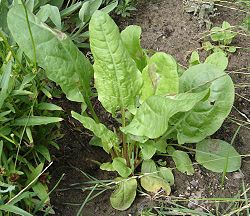
Sorrel
Did you know...
SOS Children made this Wikipedia selection alongside other schools resources. Child sponsorship helps children one by one http://www.sponsor-a-child.org.uk/.
| Sorrel | |
|---|---|
 |
|
| Scientific classification | |
| Kingdom: | Plantae |
| Division: | Magnoliophyta |
| Class: | Magnoliopsida |
| Order: | Caryophyllales |
| Family: | Polygonaceae |
| Genus: | Rumex |
| Species: | R. acetosa |
| Binomial name | |
| Rumex acetosa L. |
|
Common sorrel (Rumex acetosa), also known as spinach dock and either ambada bhaji or gongoora in Indian cuisine, is a perennial herb that is cultivated as a garden herb or leaf vegetable (pot herb).
Sorrel is a slender plant about 60 cm high, with roots that run deep into the ground, as well as juicy stems and edible, oblong leaves. The lower leaves are 7 to 15 cm in length, slightly arrow-shaped at the base, with very long petioles. The upper ones are sessile, and frequently become crimson. The leaves are eaten by the larvae of several species of Lepidoptera ( butterfly and moth) including the Blood-vein moth.
It has whorled spikes of reddish-green flowers, which bloom in June and July, becoming purplish. The stamens and pistils are on different plants ( dioecious); the ripe seeds are brown and shining.
Common sorrel has been cultivated for centuries. The leaves may be puréed in soups and sauces or added to salads and shav; they have a flavor that is similar to kiwifruit or sour wild strawberries. The plant's sharp taste is due to oxalic acid, and so may be contraindicated in people with rheumatic-type complaints, kidney or bladder stones. Sorrel is also a laxative.
In the Caribbean, sorrel typically refers to Jamaican Red Sorrel or Roselle.
